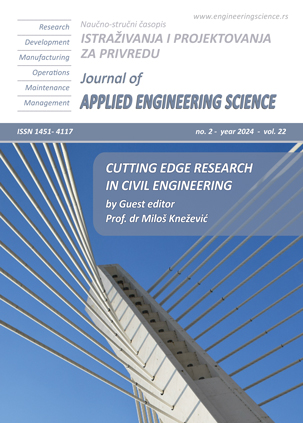DESIGN OF A COOLING SYSTEM FROM UNDERGROUND THERMAL ENERGY STORAGE (UTES, UNDERGROUND) THERMAL ENERGY STORAGE) BASED ON EXPERIMENTAL RESULTS
Abstract
Geothermal energy is a renewable and clean source that has been used for electricity generation in some countries since the 50s, the main characteristic to be used in this application is that the subsoil must have a high temperature geothermal resource (+150 °C). However, it can also be used in applications such as air conditioning in places where the temperature is around 30°C; In Europe alone, there are more than one million thermal installations operating by harnessing geothermal energy. The objective of the work was to design a cooling system from the storage of underground energy, for that, it is essential to know the variation of subsoil temperatures during a certain period of time. For this purpose, sensors were used that were installed at different depths and by means of an Arduino, information of a whole year was stored; so that these data are as representative as possible of the energy storage conditions and the changes depending on the seasons that pass. Additionally, the characteristics of the soil (conductivity, humidity and composition) were taken into account, where the equipment is intended to be installed in subsequent works. For the determination of the necessary cooling load, the design requirements of the ASHRAE standard were used and for the design of the underground heat exchanger, references of designs recommended through experimental tests in other research works are included, together with internal fluid methodology and one-dimensional heat transfer. It includes elements that can help improve the dissipation of energy into the subsurface and maintain transfer properties as stable as possible. This design is designed for the air conditioning of a classroom of normal dimensions that are used in the University and therefore avoid the energy consumption of conventional air conditioning equipment.
References
Fridleifsson, I. B. (2001). Geothermal energy for the benefit of the people. Renewable and Sustainable Energy Reviews, Vol. 5, No. 3, 299–312, DOI:10.1016/S1364-0321(01)00002-8
Doran, H. R.,Renaud, T.,Falcone, G.,Pan, L.,Verdin, P. G. (2021). Modelling an unconventional closed-loop deep borehole heat exchanger (DBHE): sensitivity analysis on the Newberry volcanic setting. Geothermal Energy, Vol. 9, No. 1, DOI:10.1186/S40517-021-00185-0
Song, C.,Li, Y.,Rajeh, T.,Ma, L.,Zhao, J.,Li, W. (2021). Application and development of ground source heat pump technology in China. Protection and Control of Modern Power Systems, Vol. 6, No. 1, DOI:10.1186/S41601-021-00195-X
Barbier, E. (2002). Geothermal energy technology and current status: An overview. Renewable and Sustainable Energy Reviews, Vol. 6, Nos. 1–2, 3–65, DOI:10.1016/S1364-0321(02)00002-3
Vienken, T.,Kreck, M.,Dietrich, P. (2019). Monitoring the impact of intensive shallow geothermal energy use on groundwater temperatures in a residential neighborhood. Geothermal Energy, Vol. 7, No. 1, DOI:10.1186/S40517-019-0123-X
Park, S.,Langat, A.,Lee, K.,Yoon, Y. (2021). Measuring the impact of risk on LCOE (levelized cost of energy) in geothermal technology. Geothermal Energy, Vol. 9, No. 1, DOI:10.1186/S40517-021-00209-9
Ochifuji, K.,Hamada, Y.,Nakamura, M. (2002). Underground Thermal Energy Storage. Nihon Enerugi Gakkaishi/Journal of the Japan Institute of Energy (Vol. 81), DOI:10.1002/9781119181002.CH4
Monzó, P. (2018). Modelling and monitoring thermal response of the ground in borehole fields. KTH Industrial Engineering and Management, Stockholm, Sweden, PhD ThesisKTH Royal Institute of Technology, Stockholm, SwedenRetrieved from http://kth.diva-portal.org/smash/get/diva2:1178493/FULLTEXT01.pdf
Márquez, J. M. A.,Bohórquez, M. Á. M.,Melgar, S. G. (2016). Ground thermal diffusivity calculation by direct soil temperature measurement. application to very low enthalpy geothermal energy systems. Sensors (Switzerland), Vol. 16, No. 3, DOI:10.3390/S16030306
Ignatowicz, M.,Melinder, Å.,Palm, B. (2017). Properties of different ethyl alcohol based secondary fluids used for GSHP in Europe and USA. Proceedings of the IGSHPA Technical/Research Conference and Expo 2017, Oklahoma, 10
Florides, G.,Kalogirou, S. (2004). Measurements of Ground Temperature at Various Depths Measurements of Ground Temperature at Various Depths. ResearchGate, No. January
Dalkilic, A. S.,Kurekci, N. A.,Kincay, O.,Wongwises, S. (2013). Fundamental Basis and Application of Cold-Room Project Design: A Turkish Case Study. Arabian Journal for Science and Engineering, Vol. 38, No. 5, 1115–1130, DOI:10.1007/S13369-012-0534-5
Laskowski, R. (2015). The black box model of a double ‑ tube counter ‑ flow heat exchanger. Heat and Mass Transfer, 1111–1119, DOI:10.1007/S00231-014-1482-2
Rees, S. J. (2016). Advances in Ground-Source Heat Pump Systems. Advances in Ground-Source Heat Pump Systems, DOI:10.1016/C2014-0-03840-3
Skarphagen, H.,Banks, D.,Frengstad, B. S.,Gether, H. (2019). Design Considerations for Borehole Thermal Energy Storage (BTES): A Review with Emphasis on Convective Heat Transfer. Geofluids, Vol. 2019, DOI:10.1155/2019/4961781
Zhang, X.,Zhang, T.,Li, B.,Jiang, Y. (2019). Comparison of four methods for borehole heat exchanger sizing subject to thermal response test parameter estimation. Energies, Vol. 12, No. 21, DOI:10.3390/EN12214067
Angel de la O Herrera, M.,Luna, A. S.,da Costa, A. C. A.,Blanco Lemes, E. M. (2015). A structural approach to the HAZOP - Hazard and operability technique in the biopharmaceutical industry. Journal of Loss Prevention in the Process Industries, Vol. 35, 1–11, DOI:10.1016/J.JLP.2015.03.002
Reuss, M.,Sanner, B. (2001). Design of Closed Loop Heat Exchangers. International Summer School on Direct Application of Geothermal Energy, Chapter 2.5, 147–156
Said,Habib,Mokheimer. (2009). Horizontal Ground Heat Exchanger Design for Ground-Coupled Heat Pumps. Ecologic Vehicles - Renewable Energies - Monaco, No. May 2014
Jin, G.,Zhang, X.,Guo, S.,Wu, X.,Bi, W. (2017). Evaluation and Analysis of Thermal Short-circuiting in Borehole Heat Exchangers. Energy Procedia, Vol. 105, 1677–1682, DOI:10.1016/J.EGYPRO.2017.03.547

